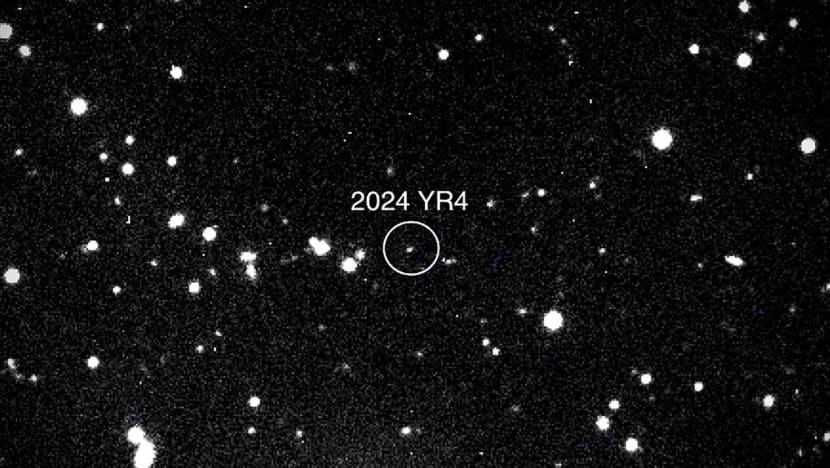What you need to know about 2024 YR4, the asteroid that could hit Earth in about eight years' time
The asteroid currently has about a 2 per cent chance of colliding with Earth in December 2032, according to NASA and the European Space Agency.

This handout picture provided by NASA on Jan 31, 2025, shows asteroid 2024 YR4 as observed by the Magdalena Ridge 2.4m telescope at the New Mexico Institute of Technology four days earlier. (File photo: AFP/NASA/New Mexico Institute of Technology)
SINGAPORE: A recently detected asteroid about the size of a football field currently has a greater than 2 per cent chance of colliding with Earth in about eight years' time.
Scientists are not panicking yet, but they are watching the asteroid, dubbed 2024 YR4, closely.
Here is what you need to know about it:
What do we know so far?
The asteroid was first spotted on Dec 27, 2024, through a telescope at the El Sauce Observatory in Chile. The telescope is part of the Asteroid Terrestrial-impact Last Alert System (ATLAS), which comprises several telescopes around the world.
ATLAS, which is funded by the United States' space agency NASA, is managed by the University of Hawaii's Institute for Astronomy.
Based on its brightness, astronomers estimate that 2024 YR4 is between 40m and 90m wide.
By New Year's Eve, the asteroid had been reported as an object of concern to Kelly Fast, acting planetary defence officer at NASA.
"You get observations, they drop off again. This one looked like it had the potential to stick around," she told AFP.
The risk assessment kept climbing, and on Jan 29, the International Asteroid Warning Network (IAWN), a global planetary defence collaboration, issued a memo on the asteroid.
2024 YR4 follows a highly elliptical four-year orbit, swinging through the inner planets before shooting past Mars and out towards Jupiter.
For now, it's zooming away from Earth – its next close pass will not come until 2028.
How has the probability of it hitting Earth changed since its discovery?
In its Jan 29 memo, IAWN said that the asteroid had a 1.3 per cent chance of impacting Earth on Dec 22, 2032, according to NASA and European Space Agency (ESA) data.
As of Feb 5, the space agencies had upped this to 1.6 per cent. On Feb 7, ESA raised the figure again, to 2.2 per cent.
As of Wednesday, ESA's figure was 2 per cent and NASA's 2.1 per cent.
The odds of an impact will continue to change and could also drop to zero.
"The odds are very good that not only will this not hit Earth, but at some point in the next months to few years, that probability will go to zero," Bruce Betts, chief scientist of The Planetary Society, told AFP.
Such a scenario unfolded in 2004 with Apophis, an asteroid initially projected to have a 2.7 per cent chance of striking Earth in 2029. Further observations ruled out an impact.
How much damage could it cause?
The most infamous asteroid impact occurred 66 million years ago, when a space rock with a width of about 10km triggered a global winter, wiping out the dinosaurs and 75 per cent of all species.
By contrast, 2024 YR4 falls into the "city killer" category – if it hits Earth, the impact will have the potential to wreak city-level devastation, depending on where it strikes.
"If you put it over Paris or London or New York, you basically wipe out the whole city and some of the environs," said Betts.
According to the IAWN memo, possible impact sites include over the eastern Pacific Ocean, northern South America, the Atlantic Ocean, Africa, the Arabian Sea and South Asia.
The best modern analogue of an impact event involving 2024 YR4 is the 1908 Tunguska event, when an asteroid or comet fragment measuring 30m to 50m in diameter exploded over Siberia, flattening 80 million trees across 2,000 sq km.
Like that impactor, 2024 YR4 would be expected to blow up in the sky, rather than leave a crater on the ground.
"We can calculate the energy ... using the mass and the speed," said Andrew Rivkin, a planetary astronomer at Johns Hopkins Applied Physics Laboratory.
For 2024 YR4, the explosion from an airburst would have the energy of about 8 megatons of TNT. In other words, the blast would have more than 500 times the power of the Hiroshima bomb.
If it explodes over the ocean, the impact would be less concerning, unless it happens near a coastline and triggers a tsunami.
Should we be worried about 2024 YR4 and is there anything the world can do about it?
The world has plenty of time to prepare for 2024 YR4, experts have stressed. And if needs be, there is one tried-and-tested means of altering an asteroid's trajectory.
Rivkin led the investigation for NASA's 2022 Double Asteroid Redirection Test, or DART, mission, which successfully nudged an asteroid off its course with a "kinetic impactor" strategy that involved a collision with a spacecraft.
The target asteroid posed no threat to Earth, making it an ideal test subject.
"I don't see why it wouldn't work" again, he said. The bigger question is whether major nations would fund such a mission if their own territory was not under threat.
Other more experimental ideas exist.
Lasers could vaporise part of the asteroid to create a thrust effect, pushing it off course. A "gravity tractor", a large spacecraft that slowly tugs the asteroid away using its own gravitational pull, has also been theorised.
China, meanwhile, has started assembling a planetary defence team to counter the threat of near-Earth asteroids.
Weeks after the asteroid's discovery, a special projects centre at China's State Administration of Science, Technology and Industry for National Defence posted a recruitment notice listing three available roles for a "planetary defence post", the South China Morning Post reported on Monday.
The centre, which is responsible for aerospace engineering research and implementation and Earth observation, is recruiting graduates to study asteroid monitoring and create early warning methods, according to the notice posted last month on the WeChat account of the journal China Space Science and Technology.
China also has an existing conceptual plan for a mission to defend against a near-Earth asteroid. Unveiled in September 2024, the mission – which would be the first of its kind for China – aims to observe an asteroid and then hit it with a spacecraft to alter its path in around 2030, according to state media.
If all else fails, the long warning time means that authorities could evacuate the impact zone.
"Nobody should be scared about this," said NASA's Fast. "We can find these things, make these predictions and have the ability to plan."


















